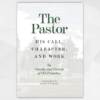Book Review: Good Christians, Good Husbands?, by Doreen Moore
Does being a good Christian make for being a good husband and family man? That’s the question Doreen Moore explores in her brief book (179 pages; 24 pages of endnotes) by looking at three of the most extraordinarily fruitful men of the eighteenth century and their wives: John and Molly Wesley, George and Elizabeth Whitefield, and Jonathan and Sarah Edwards.
The first three chapters serve as mini-biographies for the three couples, including their opinions on balancing ministry and marriage. The fourth and final chapter presents the lessons to be learned.
CHAPTER 1: WESLEY
In 1783, two years after his wife’s death, John Wesley wrote, “The person in your house that claims your first and nearest attention, is, undoubtedly your wife; seeing you are to love her, even as Christ hath loved the Church…”
According to Moore’s assessment of the Wesley union, this is a terribly ironic statement. Wesley was unwilling to stop or even slow his itinerant preaching for any reason, including his marriage. He desired “to spend and be spent” for “the Cause.” This left Molly Wesley alone most days of her marriage.
For her part, Moore does not present a flattering picture of Molly. She quotes one biographer who wrote, “As a rule, [Molly] was a bitter unmitigated curse.” Molly was jealous of the relationships Wesley had with unmarried women and spent energy to undermine her husband’s reputation. It was never clear in anyone’s mind why they married in the first place.
After a final attempt at reconciling John and Molly, Molly’s son from her first marriage summarized the relationship this way: “[I] leave matters no better than I found them. It is, indeed, a melancholy affair, and, I am afraid, productive of bad consequences.”
Wesley was so far removed from his wife’s life that he wrote the following in his journal on October 12, 1781: “I came to London, and was informed that my wife died on Monday. This evening she was buried, though I was not informed of it till a day or two after.”
CHAPTER 2: WHITEFIELD
George Whitefield married Elizabeth James—a thirty six year old widow—on November 11, 1741, just a few years after beginning his ministry. Though it’s unlikely Hollywood will ever want to present their story as a romance, Moore characterizes their marriage as “acceptable.”
In a letter to a friend, Whitefield describes Elizabeth, “[She] is neither rich in fortune, nor beautiful as to her person, but, I believe, a true child of GOD, and would not, I think, attempt to hinder me in his work for the world.” Like Wesley, Whitefield wanted to “spend and be spent” and did not want to turn down any request merely because he was married.
Why, then, was Whitefield’s marriage “acceptable” while Wesley’s was a disaster? First, Whitefield made it clear that he was looking for a “helpmeet” to work alongside him, especially in his much-loved Orphan House. Second, Elizabeth was no Molly. Elizabeth, though only converted three years before marrying Whitefield, was a godly, hard working, kind woman who was committed to the Cause in a way Molly wasn’t.
In short, she knew what she was getting into by marrying Whitefield and worked to support it. Like Wesley, Whitefield’s wife preceded him in death. The difference was that Whitefield felt a “chasm” at the loss of his bride.
CHAPTER 3: EDWARDS
Moore holds up the life of Jonathan and Sarah Edwards as the model for marriage and ministry. After all, Edwards “saw no dichotomy between ‘the work of the Lord’ and his family.” Edwards married Sarah Pierrepont on July 28, 1727 and remained in their “uncommon union” till his death in 1758.
Edwards lived out his theology which regarded the family as a display of God’s glory. He understood the family was a little church and he was its chief shepherd, taking responsibility for Sarah’s and his eleven children’s spiritual care. Though Edwards was famous for being in his study for upwards of thirteen hours each day, Moore writes, “she [Sarah] frequently accompanied him there. They often discussed religion. They prayed together at least once a day. After the rest of the family retired for the night they had a devotion” (101).
For her part, Sarah Edwards “was bright and had had an ‘enlightened and polished education.’ Her depth of thought, combined with her godliness and kindness, made her an enjoyable conversationalist. She so sought to please her husband that she did whatever it took to meet his needs” (100).
Upon her husband’s death, Sarah wrote the following to her daughter:
O my Dear Child,
What shall I say. A holy and good God has covered us with a dark cloud. O that we may all kiss the rod and lay our hands on our mouths. The Lord has done it. He has made me adore his goodness that we had him so long. But my God lives and he has my heart. O what a legacy my husband and your father has left us. We are all given to God and there I am and love to be. (127)
CHAPTER 4: HOW SHOULD WE THEN LIVE?
The final chapter presents a brief summary of the book and thirteen “Lessons to be learned and other Biblical thoughts to ponder.” For a taste, here are the first two lessons: First, being in the ministry is hard work! Second, it is entirely possible that family concerns can be given too much priority.
If you have never considered such things, the chapter may be worthwhile. If you have, pass.
ACCURACY
I have read enough biographies on the lives of all three men to assume that Moore provides a good summary of their marriages. Wesley—nasty. Whitefield—acceptable. Edwards—uncommonly good.
AGENDA
I do not know Doreen Moore, but she makes her agenda clear as she inserts her opinions and experience. In the midst of recounting the histories of these couples, she will insert a comment like this: “Though my husband and I would both say that our marriage has been a source of great joy, I confess that only within the last few years have I internalized the truth that the foundation of a healthy Christian marriage is not that my psychological needs are met” (118).
These types of comments, peppered through the book, leaves the reader feeling like she has something of an ulterior agenda. Whether or not she does, they made for odd interruptions and might have been better saved for her own autobiography.
LESSONS
There are lessons to be learned for the minister and non-minister alike from the marriages of these three couples. In fact, I think the lessons are so obvious that the author could have left chapter four out of the book.
That said, these lives and their ministries were so utterly extraordinary that any conclusions we reach about their marriages are bound to be uncharitable—at least for Wesley and Whitefield. Which of us have ever tried to manage a revival and a marriage at the same time?
Is Good Christians Good Husbands? good?
If the main lesson of this book is simply that right theology does not guarantee a good marriage, then the message comes across loud and clear. And that is a good lesson for young ministers especially to consider.
The book is a quick read. It is fun to read if you like brief bios. Given the appalling rate of infidelity among ministers, or even just unhappy ministerial homes, every pastor should consider the state of his marriage and home. Does it have the aroma of Christ? This book should help him ask that question.









